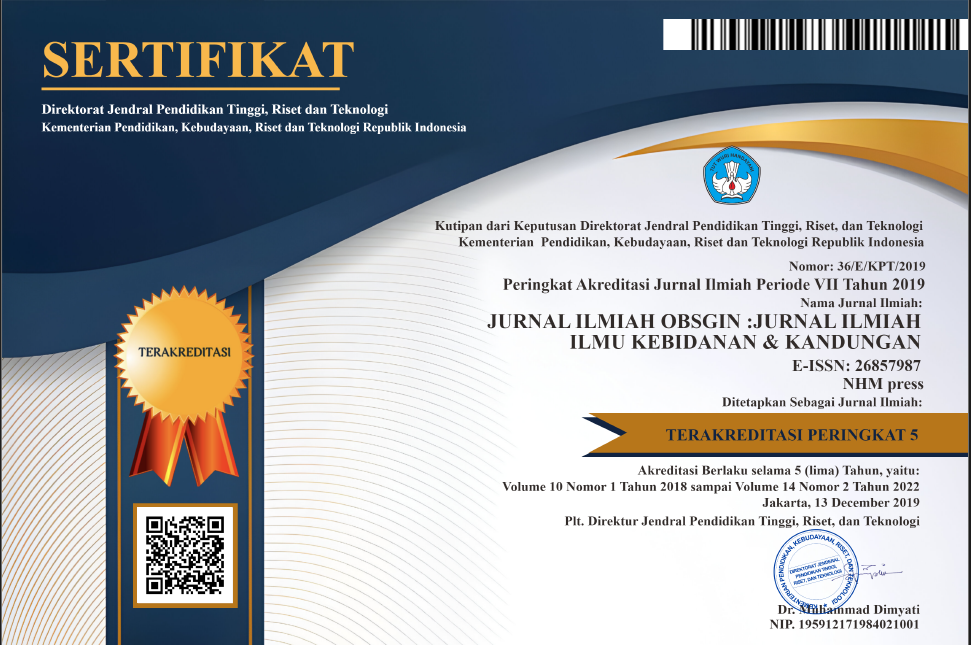Analisis Korelasi Jenis Persalinan dengan Kejadian Sindroma Baby Blues
Abstract
Baby Blues Syndrome or often also called Maternity Blues is understood as a mild affective disorder syndrome that often appears in the first week after delivery and peaks on the third to fifth day and attacks within 14 days after delivery. The incidence of baby blues or postpartum blues in Asia is quite high and varies between 26-85%, while in Indonesia the incidence of baby blues or postpartum blues is between 50-70% of postpartum women. This study aims to see the correlation between the type of delivery and the incidence of baby blues syndrome in the working area of the Benu-Benua Public Health Center, Kendari City. The research method used was an observational analytic study with a cross-sectional design which was carried out in June 2020 at the Benu-Benua Health Center working area involving 53 mothers who gave birth. The results showed that the preponderance of experiencing baby blues and how to give birth normally. The results of the Spearman test show that the correlation between variables is significant. The conclusion of this study is that there is a correlation between the type of delivery and the incidence of baby blues syndrome.
References
Aprilia, S. (2022). Faktor-Faktor Yang Berhubungan Dengan Kejadian Syndrome Baby Blues Pada Ibu Postpartum Di Klinik Bidan Ratna Dewi Kerinci Tahun 2022. Sekolah Tinggi Ilmu Kesehatan Alifah Padang.
Deniati, E. N., & Agnesfadia, S. (2022). The Effect of Sports on the Phenomenon of Baby Blues Syndrome (Postpartum Blues) in Postpartum Mothers. 5th International Conference on Sport Science and Health (ICSSH 2021), 66–74.
Dwi Lestari, D. (2021). HUBUNGAN LAMA WAKTU PERSALINAN DENGAN TERJADINYA BABY BLUES (Studi di Polindes Pangolangan Kecamatan Burneh). Stikes Ngudia Husada Madura.
Gutira, T., & Nuryanti, L. (2010). Hubungan antara dukungan keluarga dengan keadilan baby blues syndrome pada ibu post secno caesaria. Indigenous: Jurnal Ilmiah Psikologi.
KURNIA, U. M. I. (2018). Hubungan Karakteristik Ibu Postpartum dengan Kejadian Baby Blues Di Wilayah Kerja Puskesmas Kalimanah. UNIVERSITAS MUHAMMADIYAH PURWOKERTO.
Laitupa, S. A. K., Purwanti, E., & Hidayati, L. N. (2023). Pengalaman Baby blues Syndrome Pada Ibu Postpartum di Kabupaten Merauke. Journal of Pharmaceutical and Health Research, 4(1), 117–121.
Masrokah, Y. (2013). Persepsi Babyblues Syndrome pada Ibu Melahirkan di Rumah Sakit Aura Syifa Kediri. IAIN Kediri.
Rahmawati, F., & Sulistiyowati, S. (2017). Gambaran ibu postpartum dengan Baby Blues. Jurnal Kesehatan Ibu Dan Anak Akademi Kebidanan An-Nur, 1(1).
Retnosari, E., & Fatimah, S. (2022). Prevalence And Factors That Contributing of Baby Blues Syndrome On Postpartum Mothers. International Journal Scientific and Professional (IJ-ChiProf), 1(2), 64–70.
Susanti, L. W. (2016). Faktor Terjadinya Baby Blues Syndrom pada Ibu Nifas di BPM Suhatmi Puji Lestari. Jurnal Maternity, 3(2).
Susanti, L. W., & Sulistiyanti, A. (2017). Analisis Faktor-Faktor Penyebab Terjadinya Baby Blues Syndrom Pada Ibu Nifas. Infokes: Jurnal Ilmiah Rekam Medis Dan Informatika Kesehatan, 7(2).












